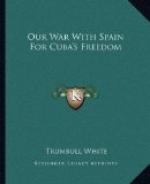General Merritt entered with his staff at 3 o’clock. The situation was then better understood, and a conference with General Jaudenes was held. The terms agreed on were as follows:
An agreement for the capitulation of the Philippines.
A provision for disarming the men who remain organized under the command of their officers, no parole being exacted.
Necessary supplies to be furnished from the captured treasury funds, any possible deficiency being made good by the Americans.
The safety of life and property of the Spanish soldiers and citizens to be guaranteed as far as possible.
The question of transporting the troops to Spain to be referred to the decision of the Washington government, and that of returning their arms to the soldiers to be left to the discretion of General Merritt.
Banks and similar institutions to continue operations under existing regulations, unless these are changed by the United States authorities.
Lieutenant Brumby, immediately after the terms of capitulation had been signed, hurried off to lower the Spanish flag—in reality to lower all Spain’s flags in the Philippines by taking down one. He was accompanied by two signal men from the Olympia.
This little party found its way after great difficulty into Fort Santiago in the northern portion of the walled city.
There a large Spanish flag was flying. Grouped about it were many Spanish officers. Brumby’s presence there in the victorious uniform attracted a crowd from the streets.
Raises the stars and stripes.
They hissed as he approached to haul down the flag. Then the stars and stripes rose in place of the other.
Many of those present wept bitterly as the flag of the victorious stranger climbed into place above the fort.
Fearing that the crowd might lower “old glory,” Lieutenant Brumby asked an American infantry officer to move up a detachment to guard it. Fortunately, he met a company coming up with a band.
The infantrymen presented arms and the band played “The Star-Spangled Banner,” accompanied by the cheers of the soldiers, in which many of the residents of the city joined.
The total American loss in the day’s battle was eight killed and thirty-four wounded. The Spaniards had 150 killed and over 300 wounded.
The Americans took 11,000 prisoners, 7,000 being Spanish regulars; 20,000 Mauser rifles, 3,000 Remingtons, eighteen modern cannon and many of the obsolete pattern.
Great credit was given to General Merritt for his plan of attack, which was successfully carried out in every detail under unusually complicated conditions. Nor was commendation withheld from Chief of Staff General Babcock for his expert co-operation in the admirably conceived strategy. Prompt action and strictly following fully detailed orders resulted in every case in the immediate settlement of every difficulty, however threatening. The conduct of the Spanish was in a few cases reprehensible, such as their setting fire to the gunboat Cebu and the destruction of several armed launches and boats after the capitulation had been agreed upon.




